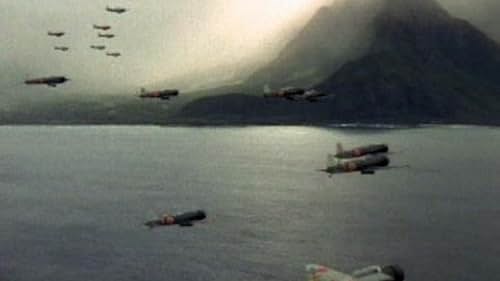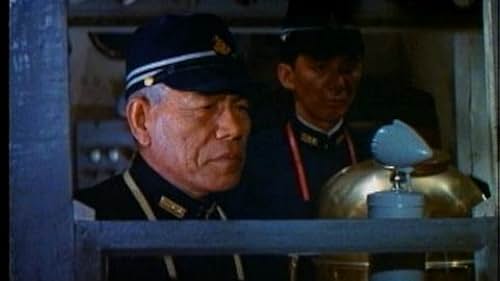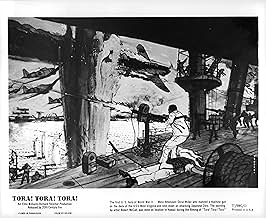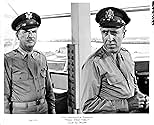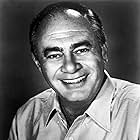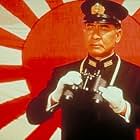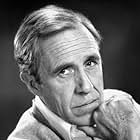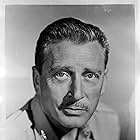The story of the 1941 Japanese air raid on Pearl Harbor, and the series of preceding American blunders that aggravated its effectiveness.The story of the 1941 Japanese air raid on Pearl Harbor, and the series of preceding American blunders that aggravated its effectiveness.The story of the 1941 Japanese air raid on Pearl Harbor, and the series of preceding American blunders that aggravated its effectiveness.
- Won 1 Oscar
- 2 wins & 7 nominations total
- Admiral Chuici Nagumo
- (as Eijiro Tono)
Storyline
Did you know
- TriviaThe previous war epic by Darryl F. Zanuck, The Longest Day (1962) was an extreme success. As stated by his son, producer Richard D. Zanuck, this was because it was about victory. He noted in contrast that Tora! Tora! Tora! is about defeat. Although the film made a great deal of money, it did nowhere near as well as The Longest Day. In Japan, however, the film was a smash. For the Japanese audience, it not only depicted a battle victory (after twenty-five years of films depicting defeat) but it also put the attack on more understandable footing; identifying not only the villains but also the motivation of those who believed that their actions were honorable.
- GoofsAs the bombers fly toward Pearl Harbor, they pass over the white cross at Scofield Barracks (Kolekole Pass) that was erected in memory of the people killed in the raid.
- Quotes
[last lines]
Admiral Isoroku Yamamoto: I had intended to deal a fatal blow to the American fleet by attacking Pearl Harbor immediately after Japan's official declaration of war. But according to the American radio, Pearl Harbor was attacked 55 minutes before our ultimatum was delivered in Washington. I can't imagine anything that would infuriate the Americans more. II fear all we have done is to awaken a sleeping giant and fill him with a terrible resolve.
- Crazy creditsFor the U.S. version of the film, the next to last of the main credits reads "Japanese Sequences Directed by Toshio Masuda Kinji Fukasaku" and the last credit reads, "Directed by Richard Fleischer." For the Japanese version of the film, the next to last credit reads, "American Sequences Directed by Richard Fleischer" and the final credit reads, "Directed by Toshio Masuda Kinji Fukasaku."
- Alternate versionsThe original release included a line by Admiral Halsey (James Whitmore) saying that after the war, Japanese will only be spoken in Hell. This line is removed from later releases.
- ConnectionsEdited into Midway (1976)
"Tora! Tora! Tora!" meticulously traces the build-up to Pearl Harbor by examining the diplomatic, military and intelligence events and developments on both sides. The film is unimpeachably even-handed, telling both sides' stories simultaneously, and interleaving the Japanese and American versions with intelligence and an almost total absence of jingoism.
Japan's warmongers considered their country to be trapped by history and geography. As the industrial nations surged forward in terms of prosperity and military might, Japan was in danger of being outstripped, having few natural resources of her own. If Japan was to compete with the USA and USSR, she would have to 'reach out' for the raw materials available in southern Asia and the Pacific, but this would mean confronting the USA, the great maritime power in the Pacific.
The film explains all this very well. We learn that the Japanese have an age-old tradition of striking against their enemies without warning, and that air superiority is the new doctrine. The brilliant Japanese planners such as Genda (played by Tatsuya Mihashi) have grasped the lessons of the European war and know the vital importance of naval air power. By 1941, battleships have become a liability - slow, lumbering dinosaurs which invite attack and cannot defend themselves against aircraft. The way forward is mobile air power, and that means aircraft carriers. If the Japanese can catch the American carriers at Pearl Harbor and destroy them, then the war will be won before it has properly started.
The Americans take a fateful decision to send out their carriers on reconnaissance missions. This strips Pearl Harbor of protection, but paradoxically ensures that Japan cannot win the war - no matter how spectacular the success of the surprise attack, the mission will fail if the US aircraft carriers survive.
Throughout the build-up, the Japanese navy chiefs such as Yamamoto (So Yamomura) have a snippet of classical Japanese poetry on their minds: "If all men are brothers, why are the winds and the waves so restless?" They take this to mean that it is the rule of nature for man to attack his fellow man. By the end of the film, Yamamoto has abandoned this view and now believes that "We have aroused a sleeping giant, and filled him with a terrible resolve."
The film catalogues the accidents and mistakes which combined to make Pearl Harbor a worse disaster for the USA than it need have been. American aircraft are bunched together in the middle of the airfield in order to reduce the risk of sabotage near the perimeter fence, but this helps the Japanese bombers to destroy them on the ground. Radar equipment cannot be placed in the best locations to give early warning, and in any event the radar data are misinterpreted when they predict the attack. Because the attack falls on a weekend, it is difficult for middle-ranking officers to contact military and political chiefs, and the contingency plans are inadequate. Radio Honolulu broadcasts through the night to guide a fleet of B-17's to Hawaii, inadvertently acting as a navigation beacon for the Japanese warplanes.
If the painstaking build-up to the attack is a little slow and ponderous, it is certainly epic in scale, and when the action erupts it comes as a mighty climax. The tension is palpable as the Japanese planes take off from their carriers, black against the ominous dawn. What follows is a breath-taking cinematic coup as Pearl Harbor is ravaged.
Verdict - A historical account of almost documentary accuracy culminates in vivid action scenes. A marvellous film.
Details
- Release date
- Countries of origin
- Languages
- Also known as
- Die Schlacht, die die Welt in Brand setzte
- Filming locations
- Production companies
- See more company credits at IMDbPro
Box office
- Budget
- $25,000,000 (estimated)
- Runtime2 hours 24 minutes
- Color
- Aspect ratio
- 2.35 : 1
Contribute to this page


